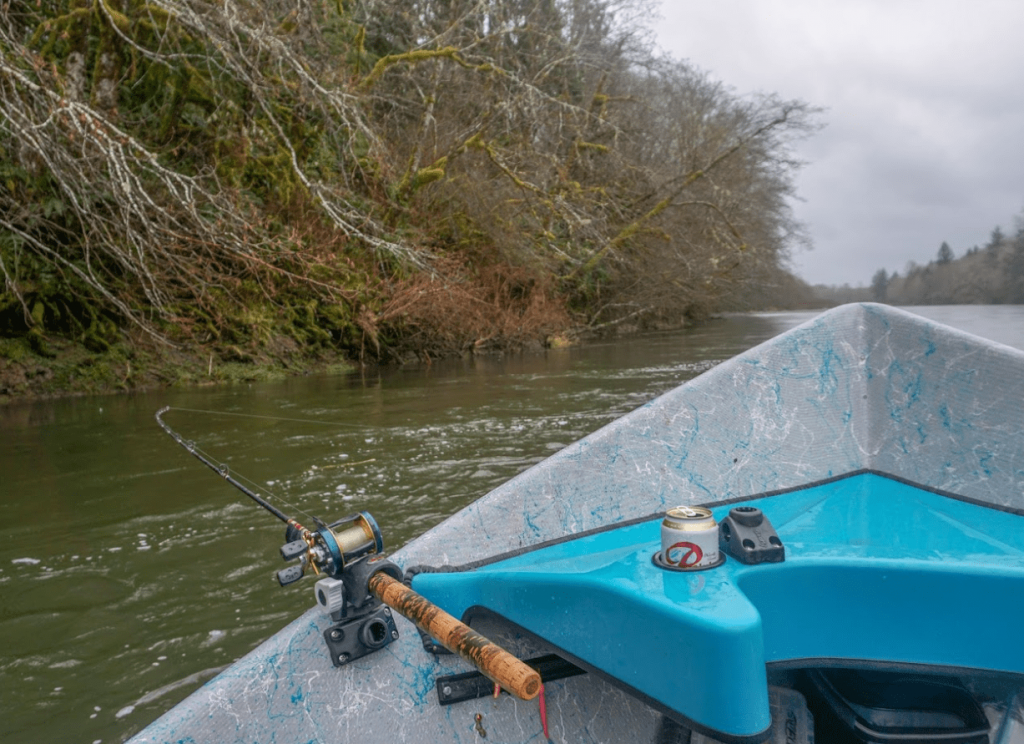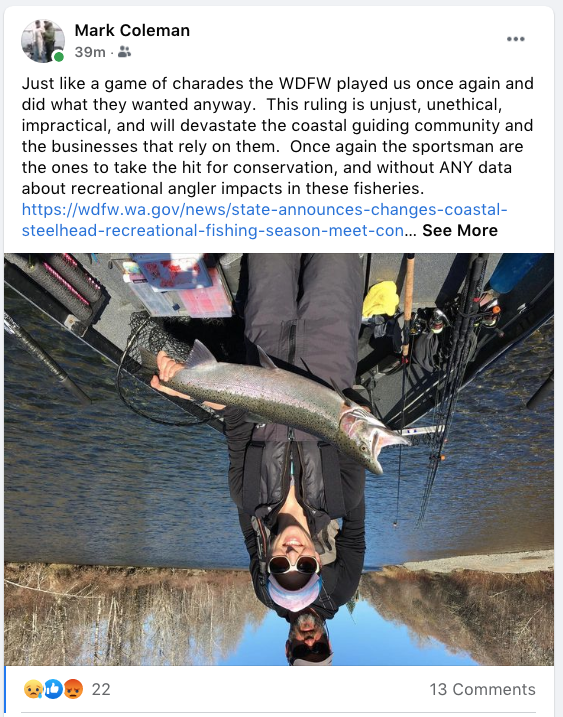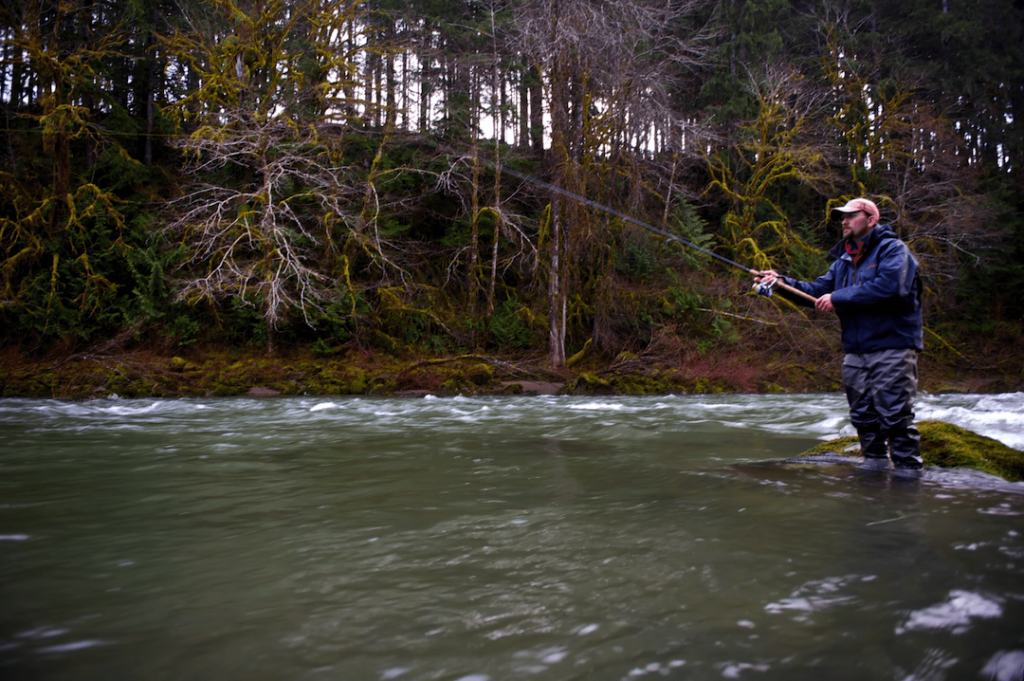Bank Fishing Only On Washington Coast Steelhead Rivers Starting In Mid-December
Washington steelheaders won’t be able to fish out of a floating device on any coastal river systems starting Dec. 14 under sweeping conservation rules for streams from the Forks area south to Willapa Bay.

Selective gear rules also go into effect that date, meaning no bait or scents afterwards in the heart of the hatchery season and only one single-point barbless hook will be allowed, plus all rainbows – trout less than 20 inches – must be released to protect these stay-in-stream juvenile steelhead.
In addition, rivers will close earlier than in the past – ranging from Feb. 1 on one small system to March 1 or April 1 on the primary winter steelhead rivers.
Anglers will still be able to use their boat to access the rivers, getting from put-ins to holes and drifts to takeouts, but just won’t be able to fish from them, it should be made clear.
Previously, bait and boat restrictions have been limited to after the early-winter fin-clipped-steelhead-directed fishery and upper sections of select rivers later in the season to protect spawners.
The rule changes are meant to protect chronic below-escapement returns of wild steelhead to numerous South and Central Coast rivers, including the Chehalis (2,000 fish fewer than spawning goals), Queets/Clearwater (637 fewer), Humptulips (534) and Willapa (344), while still providing some opportunity to harvest hatchery fish as well as a dispersed catch-and-release season for natives, support coastal economies and not focus all effort on the Quillayute.
While that last system by Forks is actually forecast to come in 3,376 fish above escapement, that’s also well down from the late 1990s.
No fishing from jet sleds, drift boats and pontoons is a massive change, as plugging, side drifting, bobber dogging and other boat-based techniques are simply the most effective ways to catch winter steelhead.
“I understand that this is going to impact some folks and the guide community has expressed great concerns,” said Kelly Cunningham, WDFW Fish Program director. “I understand those concerns, but I am also concerned about the fish.”
Guides have argued against the boat fishing ban, calling it “very discriminatory to some users” who have difficulties getting in and out of craft or trouble wading these sometimes powerful mountain streams.
WDFW models suggest it will reduce the catch by 50 percent, helping to limit interactions with wild stocks.
“Based on public feedback and analysis of catch reductions expected as a result of these regulations, this rule change provides the greatest short-term certainty of meeting our management objectives, outside of a full coastwide steelhead closure, by limiting encounters while spreading risk and creating opportunity for fishing across the entire run ” James Losee, coastal fisheries manager, said in a press release out late this afternoon. “Echoing the support we’ve heard from much of the angling and conservation community, we feel confident that this plan will break recent years’ pattern of not meeting escapement goals, while still providing opportunity for fishing.”
The state agency says that the restrictions – taken along with reduced tribal fisheries – should be enough to reach management goals.
The immediate reaction to the news was mixed, split about equally between angry faces and blue thumbs up on this blog’s Facebook page, but elsewhere on social media there were calls to defund WDFW and the agency’s call letters sitting amidst flying poop emojis.
Longtime coastal guide Mark Coleman posted an upside down picture of a steelheader in a boat, such was his reaction.

“Just like a game of charades the WDFW played us once again and did what they wanted anyway. This ruling is unjust, unethical, impractical, and will devastate the coastal guiding community and the businesses that rely on them. Once again the sportsman are the ones to take the hit for conservation, and without ANY data about recreational angler impacts in these fisheries,” stated Coleman, who, full disclosure, operates a Northwest Sportsman advertiser, All Rivers & Saltwater Charters.
Today’s announcement follows a late Thanksgiving online meeting attended by around 160 and in which WDFW laid out the challenges and options for the season. Staffers had essentially fast-tracked getting winter steelhead forecasts out as part of a commitment to improve on a midfishery closure on the Chehalis system this past season.
The four options ranged from a complete closure of all coastal streams to gear and boat restrictions on them, and opening only the Quillayute to closing the winter season early to protect the bulk of native fish.
Late last week guides met with WDFW on a proposal that they had drummed up that would have kept boat fishing open except on stretches of the upper Wynoochee and Skookumchuck.
“Select waters” is how WDFW initially broached the fishing-from-a-floating-device ban, but in true 2020 fashion, what emerged out the other end was a completely different animal, as all the waters were selected.
Meanwhile, WDFW honchoes were questioned by the Fish and Wildlife Commission this past Friday morning about the brewing rule change.
“I certainly understand the conservation piece and I also understand the rural economics piece,” Larry Carpenter of Mount Vernon said at the Friday session of the citizen panel that oversees the state agency and its chief. “But what I really don’t understand, Kelly and Kelly, is that we were not informed about this.”
The other Kelly is the director, Susewind.
“We had a Fish Committee meeting yesterday; we could have talked about it,” Carpenter said, referring to a Thursday meeting, the agenda for which lists Willapa Bay and hatchery salmon policies as topics – and certainly weighty ones – of the day. “I hate that we get caught on a Friday morning with some very distressed public folks expressing their concerns to us. It’s a little bit embarrassing to us, so I hope we can fix that in the future.”
For his part, Susewind acknowleged hearing “a lot of concerns” from anglers and others, but said that “we really need to get to this ‘conservation first.’ We keep talking about conservation first; it’s only words until you take the hard, hard steps.”
It’s all a bitter pill for lovers of the state fish – the most passionate anglers in all of the Northwest – as long-term run declines linked to habitat alterations and past overfishing have been exacerbated by poor ocean and freshwater conditions.
The Blob of 2014-15 and subsequent marine heatwaves have impacted feeding at sea and that winter’s negligible snowpack led to dried-up streams as adult steelhead returned, affecting multiple year-classes. WDFW worries that there will be another year and possibly two of low returns.
“I don’t want to be situation in five or 10 years on the coast that we’re in Puget Sound,” Cunningham said.
Puget Sound steelhead were listed under the Endangered Species Act in 2007 and, as I’ve stated on more than one occasion, with management changes before and since then, and lawsuit settlements, the fishery is a shadow of a shadow of its former self.
Cunningham says the actions comply with the statewide steelhead management plan, while also providing some fishing opportunity.
“It will be a different opportunity than in the past,” he acknowledged.

With much work to do collectively to help out our favorite fish, the rule change has the potential to splinter the steelhead community even further, as zealots lob lawsuits willy nilly at what’s left of Puget Sound’s fisheries, and bait/hardware and fly anglers bristle at each other. That will be the subject of an upcoming article in Northwest Sportsman.
Rivers that will close as of April 1 include the Bogachiel, Calawah, Dickey, Hoh, Quillayute and Sol Duc near Forks; the Clearwater, Quinault and Salmon on the west side and/or outside of Olympic National Park; the Chehalis, Elk Creek, Humptulips, Newaukum, Satsop, Skookumchuck and Wynoochee in the Grays Harbor system; and Naselle and Willapa in Willapa Bay.
Many smaller streams will close March 1, including the South Fork Calawah, Copalis, Elk, Hoquiam, Johns, Moclips, Nemah, North, Palix, Sooes (outside the Makah Reservation) and Wishkah Rivers, and Cedar, Cloquallum, Goodman, Kalaloch, Mosquito, Smith Creeks, among others.
The lower Quinault is part of the Quinault Reservation, governed by the Quinault Indian Nation, while the Queets falls under Olympic National Park jurisdiction.
For the full list, see WDFW’s emergency rule change notices.
********THE FOLLOWING IS A WDFW PRESS RELEASE*******
Fishery managers with the Washington Department of Fish and Wildlife (WDFW) today announced restrictions to sportfishing in rivers throughout the Washington coast to protect wild steelhead populations.
The restrictions will begin Dec. 14 and are expected to last through April 30 and affect all sportfishing in coastal tributaries. Among the changes:
- Fishing from a floating device is prohibited.
- Selective gear rules are in effect prohibiting the use of bait (including scents or scented materials), except only one single-point barbless hook is allowed.
- Anglers must release all wild rainbow trout.
See all affected rivers and any exceptions in the full rule change at https://fortress.wa.gov/dfw/erules/efishrules/erule.jsp?id=2611.
The rule change follows a WDFW virtual town hall discussion, attended by more than 160 members of the state’s angling community and conservation organizations, as well as more than 300 public comments the department received this fall weighing four management approaches to support long-term coastal steelhead conservation. The Statewide Steelhead Management Plan requires WDFW to meet objectives for steelhead abundance, productivity, diversity, and distribution, and WDFW analyzed suggestions from the public against those objectives.
“As fishery managers, we’re concerned with the declining abundance of wild steelhead in coastal rivers and recognize that significant changes to the status quo are needed in order to support healthy wild steelhead populations and long-term fishing opportunities,” said James Losee, Fish Program manager for WDFW’s Coastal Region. “For that reason, this measure prioritizes wild fish by meeting the objectives of the Statewide Steelhead Management Plan while still offering some limited fishing opportunity.”
Several coastal wild steelhead runs are expected to return below escapement goals and fail to meet conservation objectives, as they have the past four seasons. For example, in the Chehalis River, returns are expected to come in 2,000 fish below the escapement goal of 8,600 spawners.
“Based on public feedback and analysis of catch reductions expected as a result of these regulations, this rule change provides the greatest short-term certainty of meeting our management objectives, outside of a full coastwide steelhead closure, by limiting encounters while spreading risk and creating opportunity for fishing across the entire run ” Losee said. “Echoing the support we’ve heard from much of the angling and conservation community, we feel confident that this plan will break recent years’ pattern of not meeting escapement goals, while still providing opportunity for fishing.”
Specifically, WDFW expects that these measures will result in a more than 50 percent reduction in the number of steelhead caught across coastal waters. Combined with conservation actions from tribal co-managers, including reduced fishing time for tribal fisheries, WDFW believes that this rule change will result in meeting management objectives. These actions expand on actions the department and tribal co-managers took in 2019 to close steelhead fishing in mid-February on the Chehalis and Willapa rivers.
Losee noted that fishery managers will continue to monitor returns and assess if additional regulation changes may be needed, including potential closure of coastal steelhead fishing. State fishery managers will continue to coordinate with tribal co-managers.
“These regulation changes allow us to provide some opportunity while giving us the confidence that we will meet our conservation obligations,” said WDFW Fish Program Director Kelly Cunningham. “We continue to evaluate long-term approaches for steelhead management, prioritizing wild stocks, monitoring of fisheries, and innovative hatchery programs.”
Anglers should keep an eye on WDFW’s emergency rules webpage at https://fortress.wa.gov/dfw/erules/efishrules/ for the latest regulations, and consult the 2020-21 Sport Fishing Rules pamphlet for additional permanent regulations.
********THE FOLLOWING IS WDFW’S EMERGENCY RULE CHANGE NOTICE*******
December 8, 2020
Conservation rules implemented on Coastal tributaries
Effective date: Dec. 14, 2020, until further notice; except Elk Creek is closed to fishing until Jan. 1, 2021 and the Palix River upstream of the Middle Fork is closed to fishing until Dec. 16.
Species affected: All species.
Rules:
All species: Fishing from a floating device is prohibited. Selective Gear Rules in effect, except only one single-point barbless hook is allowed.
Rainbow trout: Release all rainbow trout.
Locations (the following waters will follow the above rules and will close to all fishing until further notice beginning on the date listed next to the water; any exceptions to the rule will also be listed next to the water):
Bear River (Pacific Co.): Closed beginning March 1, 2021.
Big River (Clallam Co.), outside Olympic National Park: Closed beginning March 1, 2021.
Bogachiel River (Clallam Co.), from the mouth to Olympic National Park boundary: Closed beginning April 1, 2021.
Calawah River: (Clallam Co.), from the mouth to the forks: Closed beginning April 1, 2021.
Calawah River, South Fork (Clallam Co.), from the mouth to Olympic National Park boundary: Closed beginning March 1, 2021.
Cedar Creek (Jefferson Co.), from the mouth to Olympic National Park boundary: Closed beginning March 1, 2021.
Chehalis River (Grays Harbor Co.), from the mouth upstream, including all forks: Closed beginning April 1, 2021.
Clearwater River (Jefferson Co.), from the mouth to Snahapish River: Closed beginning April 1, 2021.
Cloquallum Creek (Grays Harbor/Mason Co.), from the mouth to the outlet at Stump Lake: Closed beginning March 1, 2021.
Copalis River (Grays Harbor Co.): Closed beginning March 1, 2021.
Dickey River (Clallam Co.), from the Olympic National Park boundary upstream to the confluence of the east and west forks: Closed beginning April 1, 2021.
Elk Creek (Lewis/Pacific Co.): Closed beginning April 1, 2021.
Elk River (Grays Harbor Co.): Closed beginning March 1, 2021.
Goodman Creek (Jefferson Co.), outside of Olympic National Park boundary: Closed beginning March 1, 2021.
Hoh River (Jefferson Co.), from Olympic National Park boundary upstream to Olympic National Park boundary below mouth of South Fork Hoh: Closed beginning April 1, 2021.
Hoh River, South Fork (Jefferson Co.), outside of Olympic National Park boundary: Closed April 1, 2021.
Hoquiam River including West and East forks (Grays Harbor Co.): Closed beginning March 1, 2021.
Humptulips River (Grays Harbor Co.), from the mouth to confluence of East and West forks: Closed beginning April 1, 2021.
Joe Creek (Grays Harbor Co.), from the mouth to Ocean Beach Rd. Bridge: Closed beginning Jan. 1, 2021.
Johns River (Grays Harbor Co.), from the mouth (Hwy. 105 Bridge) to Ballon Creek: Closed beginning March 1, 2021.
Kalaloch Creek (Jefferson Co.), outside Olympic National Park boundary: Closed beginning March 1, 2021.
Moclips River (Grays Harbor Co.), from the mouth to Quinault Indian Reservation boundary: Closed beginning March 1, 2021.
Mosquito Creek (Jefferson Co.), from Olympic National Park boundary upstream to Goodman 30000 Mainline Bridge: Closed beginning March 1, 2021.
Naselle River (Pacific Co.), from the Hwy. 101 Bridge to the North Fork: Closed beginning April 1, 2021.
Naselle River, South (Pacific Co.), from the mouth to Bean Creek: Closed beginning March 1, 2021.
Nemah River, Middle (Pacific Co.): Closed beginning March 1, 2021.
Nemah River, North (Pacific Co.), from Hwy. 101 Bridge to Cruiser Creek: Closed beginning March 1, 2021.
Nemah River, South (Pacific Co.): Closed beginning March 1, 2021.
Newaukum River, including South Fork (Lewis Co.), from mouth to Hwy. 508 Bridge near Kearny Creek: Closed beginning April 1, 2021.
Newaukum River, Middle Fork (Lewis Co.), from mouth to Taucher Rd. Bridge: Closed beginning April 1, 2021.
Newaukum River, North (Lewis Co.), from mouth to 400′ below Chehalis City water intake: Closed beginning April 1, 2021.
North River (Grays Harbor/Pacific Co.), from the Hwy. 105 bridge to Raimie Creek: Closed beginning March 1, 2021.
Palix River (Pacific Co.): Closed beginning March 1, 2021.
Queets River (Grays Harbor/Jefferson Co.): Contact Olympic National Park for regulations. (360) 565-3000. www.nps.gov/olym/fishing.htm
Quillayute River (Clallam Co.), from Olympic National Park boundary upostream to confluence of Sol Duc and Bogachiel rivers: Closed beginning April 1, 2021.
Quinault River, Upper (Grays Harbor/Jefferson Co.), from the mouth at upper end of Quinault Lake upstream to Olympic National Park boundary: Closed beginning April 1, 2021.
Salmon River (Jefferson Co.), from outside Quinault Indian Reservation and Olympic National Park: Closed beginning March 1, 2021.
Satsop River and East Fork (Grays Harbor Co.), from the mouth to bridge at Schafer State Park, and from 400′ below Bingham Creek Hatchery dam to the dam: Closed beginning April 1, 2021.
Skookumchuck River (Lewis/Thurston Co.), from mouth to 100′ below outlet of TransAlta WDFW steelhead rearing pond located at the base of Skookumchuck Dam: Closed beginning April 1, 2021.
Smith Creek (near North River) (Pacific Co.): Closed beginning March 1, 2021.
Sol Duc River (Clallam Co.), from mouth to Hwy. 101 Bridge upstream of Klahowya campground: Closed beginning April 1, 2021.
Sooes River (Clallam Co.), outside of Makah Indian Reservation: Closed beginning March 1, 2021.
Van Winkle Creek (Grays Harbor Co.), from mouth to 400′ below outlet of Lake Aberdeen Hatchery: Closed beginning Feb. 1, 2021.
Willapa River (Pacific Co.), from mouth (City of South Bend boat launch) to Hwy. 6 Bridge (near the town of Lebam): Closed beginning April 1, 2021.
Willapa River, South Fork (Pacific Co.): Closed beginning March 1, 2021.
Wishkah River (Grays Harbor Co.), from the mouth to 200′ below the weir at the Whishkah Rearing Ponds and from 150′ upstream to 150′ downstream of the Wishkah adult attraction channel/outfall structure (within the posted fishing boundary): Closed beginning March 1, 2021.
Wynoochee River (Grays Harbor Co.): Closed beginning April 1, 2021.
